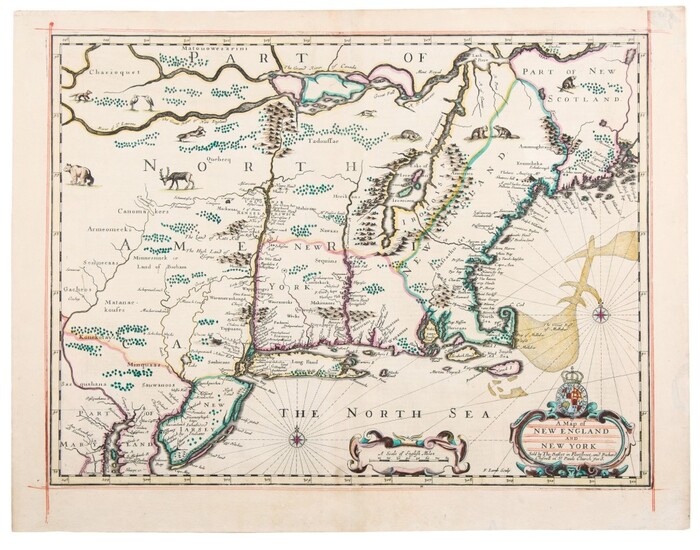Speed, John | Map of New England and New York, with original color and noble provenance
Speed, John
A Map of New England and New York. London: Thomas Basset & Richard Chiswell, [circa 1676]
Copper-engraved map (sheet size: 438 x 565 mm). Original outline color, title and margins double-ruled in red.
Speed's map of New England and New York, with striking original color, and with the title and margins double-ruled in red, denoting a noble English provenance
This highly decorative map is embellished with original color, and its title and margins are double ruled in red, a unique custom generally reserved for special presentation pieces intended for English noble patrons.
John Speed, the leading London cartographer of the Baroque period, devised his interpretation of the Jansson-Visscher sequence of New England and New York maps shortly after the English managed to definitively supplant the Dutch from control of New York and New Jersey, both provinces being renamed after British places. The major settlements of Boston, New Plymouth (Massachusetts), New York, New Castle (Delaware), New Haven, Stamford (Connecticut), and Ft. Orange (modern Albany), are named; however, this map predates the founding of Philadelphia in 1682. The outline of coastal New England is based on the work of earlier English cartographers, the most prominent being Captain John Smith. Long Island, the Hudson Valley, New Jersey, and the Delaware Basin are based on Dutch sea charts. Speed advanced his portrayal of the head of Chesapeake Bay and the delineation of the Susquehanna River from earlier maps in the sequence, taking into account the latest English information. Curiously, the interior of the region outside of the Hudson and Connecticut Valleys is shown to be wildly misunderstood. The native tribes that occupied the interior and the French, who controlled the St. Lawrence Valley (Quebec) to the north, generally did not express pleasure upon encountering foreign explorers, and this ensured that very little information regarding these regions was available to either English or Dutch cartographers. Lake Champlain—or the "Lake of Irocoisiensis"—is located far to the east of its true location, and the delineation of the St. Lawrence River is based on pure speculation. The enigmatic interior is, however, graced by the finely-engraved presence of woodland animals, such as a bear, a deer, an otter, and several beavers. The title cartouche in the lower right is elegantly surmounted by the Royal arms of England.
REFERENCE
Campbell, "The Jansson-Visscher Maps of New England," 23, in Tooley, Mapping of America 290-291; McCorkle, Early Printed Maps of New England 676.6
Condition Report:
Condition as described in catalogue entry.
View it on
Sale price
Estimate
Time, Location
Auction House
Speed, John
A Map of New England and New York. London: Thomas Basset & Richard Chiswell, [circa 1676]
Copper-engraved map (sheet size: 438 x 565 mm). Original outline color, title and margins double-ruled in red.
Speed's map of New England and New York, with striking original color, and with the title and margins double-ruled in red, denoting a noble English provenance
This highly decorative map is embellished with original color, and its title and margins are double ruled in red, a unique custom generally reserved for special presentation pieces intended for English noble patrons.
John Speed, the leading London cartographer of the Baroque period, devised his interpretation of the Jansson-Visscher sequence of New England and New York maps shortly after the English managed to definitively supplant the Dutch from control of New York and New Jersey, both provinces being renamed after British places. The major settlements of Boston, New Plymouth (Massachusetts), New York, New Castle (Delaware), New Haven, Stamford (Connecticut), and Ft. Orange (modern Albany), are named; however, this map predates the founding of Philadelphia in 1682. The outline of coastal New England is based on the work of earlier English cartographers, the most prominent being Captain John Smith. Long Island, the Hudson Valley, New Jersey, and the Delaware Basin are based on Dutch sea charts. Speed advanced his portrayal of the head of Chesapeake Bay and the delineation of the Susquehanna River from earlier maps in the sequence, taking into account the latest English information. Curiously, the interior of the region outside of the Hudson and Connecticut Valleys is shown to be wildly misunderstood. The native tribes that occupied the interior and the French, who controlled the St. Lawrence Valley (Quebec) to the north, generally did not express pleasure upon encountering foreign explorers, and this ensured that very little information regarding these regions was available to either English or Dutch cartographers. Lake Champlain—or the "Lake of Irocoisiensis"—is located far to the east of its true location, and the delineation of the St. Lawrence River is based on pure speculation. The enigmatic interior is, however, graced by the finely-engraved presence of woodland animals, such as a bear, a deer, an otter, and several beavers. The title cartouche in the lower right is elegantly surmounted by the Royal arms of England.
REFERENCE
Campbell, "The Jansson-Visscher Maps of New England," 23, in Tooley, Mapping of America 290-291; McCorkle, Early Printed Maps of New England 676.6
Condition Report:
Condition as described in catalogue entry.



